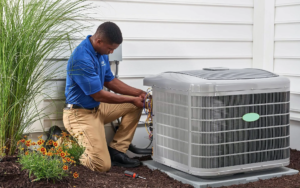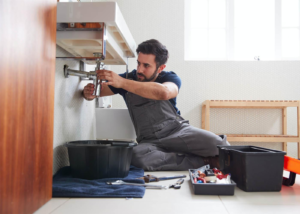Plumber makes sure that we have access to clean water and drainage systems that allow us to dispose of waste safely. They also contribute to our health by keeping our showers and bathtubs ready for use.

They also collaborate with other professionals on construction projects to ensure that plumbing infrastructure meets all necessary standards and regulations. This career is definitely not for people who don’t like getting their hands dirty.
The job duties of a plumber include laying pipes, installing toilets, sinks, and faucets, connecting systems for drainage, sewage, and water supply, and repairing leaks and clogs. They also need to be familiar with building codes and regulations. Plumbers often work on plumbing systems in both residential and commercial buildings.
Plumbers may specialize in different types of systems. Some focus on plumbing fixtures and appliances in residential buildings, while others work with large-scale water and gas distribution systems in commercial structures. In addition, plumbers must be able to read and interpret blueprints and architectural drawings in order to design and install the necessary plumbing infrastructure for new construction projects.
Other responsibilities include maintaining and inspecting existing plumbing systems to identify any issues or problems. This includes using specialized tools to test pipes for leaks, checking pressure levels, and locating blockages. They must be able to fix these issues as quickly and efficiently as possible. Plumbers also need to keep records of their work and follow company policies and procedures.
Plumbers also need to have good customer service skills. They must be able to communicate effectively with clients, explain complex issues in simple terms, and provide accurate estimates for their work. Additionally, plumbers need to be physically able to lift heavy equipment and tools.
A career as a plumber can be very rewarding, but it requires a great deal of technical knowledge and practical skill. It is important for plumbers to stay up-to-date on the latest plumbing trends and techniques in order to remain competitive in the industry. Additionally, plumbers must be able to work well as part of a team and manage their time effectively.
If you’re interested in becoming a plumber, the first step is to find a vocational school or apprenticeship program that offers training and certification. After completing an apprenticeship, you can become a journeyman plumber and start your own business or work for an established plumbing company. In addition, it’s also a good idea to join a professional trade organization that can offer continuing education opportunities and networking events.
Education and Training Requirements
Whether they are identifying a leak or clearing a blockage, plumbers must be able to solve problems quickly and effectively. This requires excellent critical thinking skills as well as the ability to weigh options and come up with creative solutions. They also need to be good at negotiating and communicating with customers to determine their needs. Finally, they must be able to work safely and follow all relevant regulations.
Getting the right education and training is an essential first step for aspiring plumbers. A high school diploma is typically a minimum requirement, but some choose to attend a vocational or trade school to obtain a more thorough education in plumbing. These programs often cover topics like local plumbing codes and regulations, pipefitting, and blueprint reading. They can also be helpful for preparing for the plumber certification exam.
Many aspiring plumbers choose to enter an apprenticeship program after graduating from a vocational or trade school. These programs match apprentices with experienced professionals who can teach them the necessary skills. They typically last four to five years and combine on-the-job training with classroom instruction. There are a variety of apprenticeship opportunities available, and exploring job websites or contacting companies directly is a great place to start.
After completing their apprenticeship, aspiring plumbers must pass the plumber certification exam. This is a comprehensive test that evaluates their knowledge of plumbing systems and components, as well as safety regulations and best practices. There are a number of ways to prepare for this exam, including studying extensively and taking practice tests.
Once certified, plumbers must continue to expand their skill set and keep up with industry trends. This can be done through continuing education courses, seminars, or conferences. Some aspiring plumbers also choose to pursue professional certifications, which can help them stand out from their peers and demonstrate their expertise in specific areas. For example, some plumbers may become certified in green plumbing practices or in working with specific types of equipment.
Work Environment
Plumbing offers an exciting career with excellent income potential and the ability to work for yourself. It requires a hands-on approach to problem-solving that is mentally stimulating and challenging. In addition, plumbers regularly interact with customers and must provide exceptional customer service. The work can also be physically demanding and may require some lifting. However, many people find this career satisfying and enjoyable.
Plumbers often work in office buildings, hospitals, factories and other large-scale commercial settings. These environments are different from residential construction sites and present unique challenges. Depending on the size and type of business, these environments may include complex plumbing systems that serve multiple occupants. In these situations, plumbers will need to collaborate with building architects and other construction teams to ensure that all plumbing systems are properly integrated into the building infrastructure.
In addition, many plumbers will need to use special equipment and tools to inspect plumbing systems and identify problems. These tools can be quite dangerous, and a plumber should exercise caution when using them. Plumbers should also be aware of safety issues related to sewage, raw sewage, and other biohazards. Additionally, they may be exposed to electricity, extreme temperatures, and other environmental hazards.
Due to the nature of their job, plumbers are frequently exposed to a variety of health and safety risks. This can include exposure to toxic substances, electrical shock, burns, and musculoskeletal injuries. They also face the risk of injury when working in cramped spaces and climbing ladders. In addition, plumbers may be exposed to hazardous waste materials and must follow proper disposal procedures.
The work environment for a plumber can be stressful, as they are often subjected to time pressures and must complete tasks quickly. Some plumbers may feel competitiveness among colleagues, but this is generally not a major source of stress for most.
Salary
Plumbers typically earn above-average salaries, making this a lucrative career choice. However, earnings vary depending on a number of factors, including geographic location, license type, specialization, and employment status. Some plumbers choose to join unions, which can offer a safety net and boost earning potential.
Generally, plumbers with more experience tend to make higher wages. Additionally, specialized skills like troubleshooting and repair of complex plumbing systems can command a premium. Continuing education also helps to ensure that plumbers stay up-to-date on technological advances and industry regulations.
Regional differences in labor costs and living expenses also impact plumber salaries. Alaska, for instance, pays the highest salaries to plumbers, followed by Oregon and North Dakota. In general, metropolitan areas offer higher wages than rural regions due to higher demand for plumbing services and a larger pool of skilled workers.
In addition to the salary, many plumbers receive generous benefits and perks like health insurance and vacation time. Many employers also provide tools and equipment, which can significantly reduce a plumber’s out-of-pocket expenses. Some plumbers also choose to start their own plumbing businesses, which can offer greater flexibility and a chance to become more successful.
A thriving economy is typically good for the plumbing industry, as it can lead to more new construction and renovation projects. It can also increase the need for plumbers to service existing systems, which is typically a steady source of revenue. Conversely, a slow economy may hurt job prospects and lower plumber wages.
The average salary for plumbers is $59,880. Those with more experience and specialized skills can earn much more, while those who work in unions are typically paid higher salaries. Additionally, many plumbers make more money if they specialize in commercial or residential plumbing, as this can increase their earning potential.
While the career outlook for plumbers is positive, it’s important to keep in mind that many new jobs will be created by replacing retirees and changing careers. The job growth is expected to be around 2%, which is still above average for most professions. In the long run, the industry will remain a stable and lucrative career choice for those with the right skills, education, and certifications.



